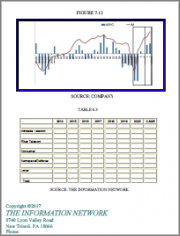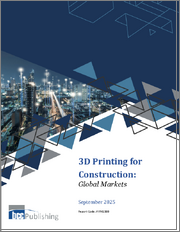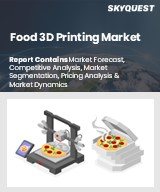
|
시장보고서
상품코드
1800294
세라믹 3D 프린팅 시장 : 예측(2025-2030년)Ceramic 3D Printing Market - Forecasts fom 2025 to 2030 |
||||||
세라믹 3D 프린팅 시장은 2025년 3억 2,350만 5,000달러에서 2030년에는 8억 2,388만 달러로 성장할 것으로 예측되며, CAGR 20.56%로 성장할 전망입니다.
세라믹 3D 프린팅 시장은 특히 헬스케어, 항공우주, 자동차 등 다양한 산업에서 채용이 증가하고 있어 큰 성장이 전망되고 있습니다. 이 첨단 제조 기술은 복잡하고 고성능 세라믹 부품의 제조를 가능하게 하며, 맞춤형 고정밀 부품 수요를 충족합니다. 개발의 원동력이 되고 있는 것은 연구개발(R&D) 투자 증가, 고온 용도에 대한 요구, 제품 혁신을 지지하는 기술력입니다. 고비용과 기술적 복잡성과 같은 과제에도 불구하고 견조한 산업 수요와 진화하는 용도에 힘입어 시장 전망은 계속 견조합니다.
시장 성장 촉진요인
주요 촉진요인은 최종 이용 산업에서 세라믹 3D 프린팅의 사용 확대이며, 특히 고강도, 내열성, 복잡한 설계가 필요한 용도 분야에서 두드러집니다. 의료 부문에서는 생체적합성 및 정확성을 높이기 위한 연구개발 투자로 뼈 임플란트 및 기타 의료 부품에 대한 사용이 증가하고 있습니다. 항공우주 및 자동차 부문은 엔진 부품 및 경량 구조와 같은 우수한 기계적 특성을 가진 재료를 필요로 하는 고온 용도에 세라믹 3D 프린팅을 활용합니다. 진화하는 설계 요구 사항을 충족하는 효율적인 솔루션을 추구하는 산업에서는 제품의 신속한 프로토타입과 맞춤화가 가능한 세라믹 3D 프린팅이 시장 성장을 더욱 가속화하고 있습니다. 특히 고성능 환경에서 세라믹 3D 프린팅 용도의 확대를 목표로 하는 투자가 향후 5년간 지속적인 수요를 촉진할 것으로 예측됩니다.
목차
제1장 주요 요약
제2장 시장 현황
- 시장 개요
- 시장 정의
- 조사 범위
- 시장 세분화
제3장 비즈니스 상황
- 시장 성장 촉진요인
- 시장 성장 억제요인
- 시장 기회
- Porter's Five Forces 분석
- 산업 밸류체인 분석
- 시책과 규제
- 전략적 제안
제4장 기술 전망
제5장 세라믹 3D 프린팅 시장 : 재료 유형별
- 서문
- 알루미나(Al2O3)
- 지르코니아(ZrO2)
- 탄화규소(SiC)
- 질화규소(Si3N4)
- 석영
- 기타
제6장 세라믹 3D 프린팅 시장 : 최종 사용자별
- 서문
- 헬스케어
- 자동차
- 항공우주 및 방위
- 일렉트로닉스
- 산업기계
- 아트, 디자인 및 소비재
- 연구 및 교육
제7장 세라믹 3D 프린팅 시장 : 지역별
- 서문
- 북미
- 재료 유형별
- 최종 사용자별
- 국가별
- 미국
- 캐나다
- 멕시코
- 남미
- 재료 유형별
- 최종 사용자별
- 국가별
- 브라질
- 아르헨티나
- 기타
- 유럽
- 재료 유형별
- 최종 사용자별
- 국가별
- 영국
- 독일
- 프랑스
- 스페인
- 기타
- 중동 및 아프리카
- 재료 유형별
- 최종 사용자별
- 국가별
- 사우디아라비아
- 아랍에미리트(UAE)
- 기타
- 아시아태평양
- 재료 유형별
- 최종 사용자별
- 국가별
- 중국
- 일본
- 인도
- 한국
- 대만
- 기타
제8장 경쟁 환경 및 분석
- 주요 기업 및 전략 분석
- 시장 점유율 분석
- 합병, 인수, 합의 및 콜라보레이션
- 경쟁 대시보드
제9장 기업 프로파일
- 3D CERAM
- ExONE GmbH
- Admatec Europe
- Steinbach AG
- 3D Systems Inc.
- Aon Inni
- Ceramtec GmbH
- Zrapid Tech
- International Syalons
- Formlabs
제10장 부록
- 통화
- 전제조건
- 기준 연도 및 예측 연도 타임라인
- 이해 관계자에 대한 주요 이점
- 조사 방법
- 약어
The Ceramic 3D Printing Market is expected to grow from USD 323.505 million in 2025 to USD 823.880 million in 2030, at a CAGR of 20.56%.
The ceramic 3D printing market is poised for significant growth, driven by increasing adoption across diverse industries, particularly healthcare, aerospace, and automotive. This advanced manufacturing technology enables the production of complex, high-performance ceramic components, meeting the demand for customized, high-precision parts. The market is fueled by rising investments in research and development (R&D), the need for high-temperature applications, and the technology's ability to support product innovation. Despite challenges such as high costs and technical complexities, the market's outlook remains strong, supported by robust industrial demand and evolving applications.
Market Drivers
The primary driver is the growing use of ceramic 3D printing in end-user industries, particularly for applications requiring high strength, thermal resistance, and intricate designs. In healthcare, the technology is increasingly utilized for bone implants and other medical components, driven by R&D investments to enhance biocompatibility and precision. The aerospace and automotive sectors leverage ceramic 3D printing for high-temperature applications, such as engine components and lightweight structures, which demand materials with superior mechanical properties. The ability to rapidly prototype and customize products further accelerates market growth, as industries seek efficient solutions to meet evolving design requirements. Investments aimed at expanding the scope of ceramic 3D printing applications, particularly in high-performance environments, are expected to drive sustained demand over the next five years.
Market Segmentation
The market is segmented by end-user and geography. Key end-user industries include healthcare, automotive, aerospace and defense, and others. Healthcare leads due to the growing demand for custom implants and dental restorations, while aerospace and defense utilize ceramic 3D printing for durable, heat-resistant components. The automotive sector benefits from the technology's ability to produce lightweight, complex parts for enhanced vehicle performance. Geographically, the market spans North America, South America, Europe, the Middle East and Africa, and Asia Pacific, with demand driven by regional industrial capabilities and technological adoption. Key countries within these regions contribute to growth based on their manufacturing ecosystems and R&D investments.
Industry Analysis
Porter's Five Forces model provides a comprehensive evaluation of the competitive landscape, analyzing factors such as supplier power, buyer influence, and market rivalry. An industry value chain analysis identifies key players involved in material development, printer manufacturing, and service provision, highlighting their roles in delivering innovative solutions. The regulatory framework, including standards for material safety and quality, is critical for ensuring the reliability of 3D-printed ceramic components, particularly in healthcare and aerospace applications. These regulations shape market dynamics and foster trust in the technology's capabilities.
Competitive Landscape
The competitive landscape is mapped through a vendor matrix, categorizing key players into leaders, followers, challengers, and niche providers based on their strategies and market positioning. Companies are investing heavily in R&D to develop advanced printers and materials, aiming to reduce costs and enhance print quality. These efforts focus on improving scalability and expanding application areas to maintain a competitive edge.
Challenges
High initial costs for ceramic 3D printing equipment and the technical complexity of achieving consistent material properties pose barriers to adoption. Additionally, the need for skilled operators and robust quality control systems adds to implementation challenges.
The ceramic 3D printing market is set for robust growth, driven by its adoption in healthcare, aerospace, and automotive industries, supported by R&D investments and the demand for high-performance, customized components. North America and Asia Pacific are key growth regions, leveraging advanced manufacturing ecosystems. While cost and technical challenges persist, ongoing innovation and regulatory support position ceramic 3D printing as a transformative technology with significant potential across diverse applications.
Key Benefits of this Report:
- Insightful Analysis: Gain detailed market insights covering major as well as emerging geographical regions, focusing on customer segments, government policies and socio-economic factors, consumer preferences, industry verticals, and other sub-segments.
- Competitive Landscape: Understand the strategic maneuvers employed by key players globally to understand possible market penetration with the correct strategy.
- Market Drivers & Future Trends: Explore the dynamic factors and pivotal market trends and how they will shape future market developments.
- Actionable Recommendations: Utilize the insights to exercise strategic decisions to uncover new business streams and revenues in a dynamic environment.
- Caters to a Wide Audience: Beneficial and cost-effective for startups, research institutions, consultants, SMEs, and large enterprises.
What do businesses use our reports for?
Industry and Market Insights, Opportunity Assessment, Product Demand Forecasting, Market Entry Strategy, Geographical Expansion, Capital Investment Decisions, Regulatory Framework & Implications, New Product Development, Competitive Intelligence
Report Coverage:
- Historical data from 2020 to 2024 & forecast data from 2025 to 2030
- Growth Opportunities, Challenges, Supply Chain Outlook, Regulatory Framework, and Trend Analysis
- Competitive Positioning, Strategies, and Market Share Analysis
- Revenue Growth and Forecast Assessment of segments and regions including countries
- Company Profiling (Strategies, Products, Financial Information, and Key Developments among others.
Different segments covered under the Ceramic 3D Printing market report are as below:
By Material Type
- Alumina (Al?O?)
- Zirconia (ZrO?)
- Silicon Carbide (SiC)
- Silicon Nitride (Si?N?)
- Quartz
- Others
By End-User
- Healthcare
- Automotive
- Aerospace & Defense
- Electronics
- Industrial & Machinery
- Art & Design / Consumer Goods
- Research & Education
By Geography
- North America
- South America
- Europe
- Middle East and Africa
- Asia Pacific
TABLE OF CONTENTS
1. EXECUTIVE SUMMARY
2. MARKET SNAPSHOT
- 2.1. Market Overview
- 2.2. Market Definition
- 2.3. Scope of the Study
- 2.4. Market Segmentation
3. BUSINESS LANDSCAPE
- 3.1. Market Drivers
- 3.2. Market Restraints
- 3.3. Market Opportunities
- 3.4. Porter's Five Forces Analysis
- 3.5. Industry Value Chain Analysis
- 3.6. Policies and Regulations
- 3.7. Strategic Recommendations
4. TECHNOLOGICAL OUTLOOK
5. CERAMIC 3D PRINTING MARKET BY MATERIAL TYPE
- 5.1. Introduction
- 5.2. Alumina (Al2O3)
- 5.3. Zirconia (ZrO2)
- 5.4. Silicon Carbide (SiC)
- 5.5. Silicon Nitride (Si3N4)
- 5.6. Quartz
- 5.7. Others
6. CERAMIC 3D PRINTING MARKET BY END-USER
- 6.1. Introduction
- 6.2. Healthcare
- 6.3. Automotive
- 6.4. Aerospace & Defense
- 6.5. Electronics
- 6.6. Industrial & Machinery
- 6.7. Art & Design / Consumer Goods
- 6.8. Research & Education
7. CERAMIC 3D PRINTING MARKET BY GEOGRAPHY
- 7.1. Introduction
- 7.2. North America
- 7.2.1. By Material Type
- 7.2.2. By End-User
- 7.2.3. By Country
- 7.2.3.1. USA
- 7.2.3.2. Canada
- 7.2.3.3. Mexico
- 7.3. South America
- 7.3.1. By Material Type
- 7.3.2. By End-User
- 7.3.3. By Country
- 7.3.3.1. Brazil
- 7.3.3.2. Argentina
- 7.3.3.3. Others
- 7.4. Europe
- 7.4.1. By Material Type
- 7.4.2. By End-User
- 7.4.3. By Country
- 7.4.3.1. United Kingdom
- 7.4.3.2. Germany
- 7.4.3.3. France
- 7.4.3.4. Spain
- 7.4.3.5. Others
- 7.5. Middle East and Africa
- 7.5.1. By Material Type
- 7.5.2. By End-User
- 7.5.3. By Country
- 7.5.3.1. Saudi Arabia
- 7.5.3.2. UAE
- 7.5.3.3. Others
- 7.6. Asia Pacific
- 7.6.1. By Material Type
- 7.6.2. By End-User
- 7.6.3. By Country
- 7.6.3.1. China
- 7.6.3.2. Japan
- 7.6.3.3. India
- 7.6.3.4. South Korea
- 7.6.3.5. Taiwan
- 7.6.3.6. Others
8. COMPETITIVE ENVIRONMENT AND ANALYSIS
- 8.1. Major Players and Strategy Analysis
- 8.2. Market Share Analysis
- 8.3. Mergers, Acquisitions, Agreements, and Collaborations
- 8.4. Competitive Dashboard
9. COMPANY PROFILES
- 9.1. 3D CERAM
- 9.2. ExONE GmbH
- 9.3. Admatec Europe
- 9.4. Steinbach AG
- 9.5. 3D Systems Inc.
- 9.6. Aon Inni
- 9.7. Ceramtec GmbH
- 9.8. Zrapid Tech
- 9.9. International Syalons
- 9.10. Formlabs
10. APPENDIX
- 10.1. Currency
- 10.2. Assumptions
- 10.3. Base and Forecast Years Timeline
- 10.4. Key Benefits for the Stakeholders
- 10.5. Research Methodology
- 10.6. Abbreviations



















